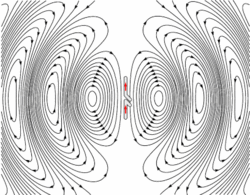Let's say I shine light upon a surface and observe a specular reflection. If I look with a electron microscope, I see tiny particles much smaller than the wavelength of light (~10 nm) and also closely spaced (~10 nm). I know that these tiny particles are very absorbent but it turns out, they reflect light very well too.
Moreover, since the particles are much smaller than the wavelength of light, a quasi-static approximation is valid, i.e. the particle sees uniform field and can be considered as oscillating dipoles.
Now, absorption can be explained due to decay of the oscillation into non-radiative processes. However, reflection less so. I have read multiple articles and looked for different sources. It seems that the phenomenon is akin to what is the origin of the Brewster angle.
From Wikipedia:
The physical mechanism for this [Brewster angle] can be qualitatively understood from the manner in which electric dipoles in the media respond to p-polarized light. One can imagine that light incident on the surface is absorbed, and then re-radiated by oscillating electric dipoles at the interface between the two media. The polarization of freely propagating light is always perpendicular to the direction in which the light is travelling. The dipoles that produce the transmitted (refracted) light oscillate in the polarization direction of that light. These same oscillating dipoles also generate the reflected light. However, dipoles do not radiate any energy in the direction of the dipole moment. If the refracted light is p-polarized and propagates exactly perpendicular to the direction in which the light is predicted to be specularly reflected, the dipoles point along the specular reflection direction and therefore no light can be reflected.
Now, I try to imagine many dipoles radiating perpendicular to the dipole moment as:
In the case of the Brewster angle, the question is how a surface can have such contrast in s- vs p-pol reflected intensity. Here, I want to understand how randomly distributed oscillating dipoles (excited by an incident EM plane wave) can generate specular reflection for s-polarization.
The way I see it, is that once excited, the dipoles will radiate (like in the gif) and, due to interference, only specular reflection is observed. Obviously this explanation is very crude and limited... I sense that coupling shouldn't be left out since the particles are also close enough that their dipole interact. Is there a "simple" explanation to explain/understand why a bunch of dipoles (randomly distributed) can generate specular reflection?


